Before you start ripping out walls, learn how to flip houses like a pro so you protect every dollar you invest.
House flipping looks simple on TV.
But in real life, one rushed decision or weak plan can erase your entire profit.
You’re not just picking finishes, you’re running a real estate investing project with real risk, tight timelines, and holding costs that never stop.
But when you learn how to flip a house the right way, you treat every step like a business move, from your first market scan to your final open houses.
This guide walks you through clear, proven steps professional house flippers use to choose the right property, control renovation costs, and design plans that local buyers love.
By the end, you will know exactly how to plan each house flip so you save money, lower stress, and maximize profit on every deal.
Key Takeaways
- Successful house flipping starts with a clear business plan that covers your market, budget, holding costs, and exit strategy.
- The right property is one where the purchase price plus renovation costs and selling costs stay well below the property’s after-repair value.
- The design and planning stage is one of the most important steps since it lays the foundation for maximum profits.
- Cedreo lets house flippers test multiple floor plan options in hours, as well as create professional 2D & 3D plans and renderings.
Why trust us? Here at Cedreo, we’ve got 20+ years of experience working with housing pros in the home design space. We know what it takes for house flippers to streamline the design process so you can start flipping houses and make more money!
See How You Can Create Complete Projects with Cedreo
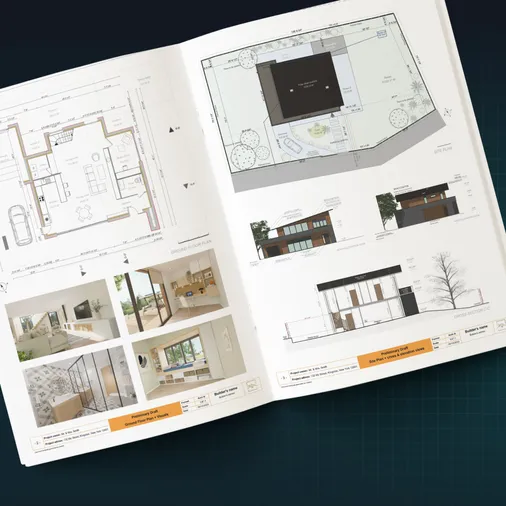
Plans – Get site plans, 2D floor plans, electrical plans, cross sections and elevation views — with all the technical details you need for a comprehensive project overview.
3D Visualizations – Use interior and exterior 3D renderings as well as 3D floor plans to help clients understand the finished project.
Documentation – Manage all your visual documents in one place, so it’s easier to present and sell your projects.
No credit card required, no commitment
Step 1: Create Your Business Plan
A clear business plan turns house flipping from a “guestimate” into a real strategy.
Market Research
- Study recent real estate listings and sold comps in your target neighborhoods so you see what a move‑in‑ready flipped house actually sells for.
- Look at days on market, price reductions, and final sale prices.
- Identify the most common home purchase price ranges, bedroom and bathroom counts, and must‑have features across those sold homes.
- Flag any up-and-coming areas where older homes are being updated and real estate investors are already active.
- Talk with a local real estate agent about which layouts and finishes are pulling multiple offers so your design matches demand.
Financial Planning
Lay out your basic finance picture in simple terms so you know how much money you can safely put into each house flip.
Use a quick table to track the key figures that drive every real estate investing decision.
| Key figure | What it tells you |
| Maximum purchase price | The highest you can pay for the property without losing money. |
| Estimated repair costs | How big a renovation you can afford on this deal. |
| Monthly holding costs | How long you can carry the flip before you must sell. |
| Target gross profit | The minimum profit that makes the risk worth it. |
| Cash reserves | How much cushion you have for unexpected costs. |
Include closing costs, selling costs, taxes, insurance, and interest on any hard money loans or private lenders so you see the true total project cost.
Team Building
- Choose a local real estate agent who regularly works with real estate investors and brings you solid real estate deals instead of retail‑ready homes.
- Line up reliable contractors and trades who can price work accurately from plans and show up consistently.
- Work with a trusted home inspector to reduce the chance of expensive surprises.
- Build relationships with lenders who understand how to flip a house, whether that is a bank, hard money lender, or private lender, so you can secure funding quickly when the right property appears.
- Plan to use design tools like Cedreo to share clear 2D and 3D plans with your team so everyone understands the property’s after-repair vision from day one.
Step 2: Find the Right Property
Location Analysis
When you learn how to flip a house the right way, your profit starts with picking the right street, not the right paint color.
Focus on neighborhoods where house flipping is already working or up-and-coming areas where older homes are being updated and real estate investors are active.
Use recent real estate listings to see what move in ready homes are selling for so you understand true market value.
These signs show a strong location.
- Several renovated homes within a few blocks.
- Days on market under the local average.
- Clean sidewalks, maintained yards, and few vacant houses.
- Amenities nearby that local buyers care about, like parks and shops.
The 70% Rule for Flipping Houses
The 70% rule gives house flippers a quick way to avoid overpaying for an investment property.
It says your maximum buying price should be no more than seventy percent of the property’s after-repair value (ARV), minus estimated repair costs.
Here’s an example of how to run the math.
| Number | Example |
| Property’s ARV | 320,000 dollars |
| 70 percent of ARV | 224,000 dollars |
| Minus repair costs | 60,000 dollars |
| Maximum purchase price | 164,000 dollars |
If the purchase price is higher than this maximum, you risk losing money after closing costs, holding costs, and selling costs.
Property Evaluation
Walk each house flip with a checklist so you spot costly problems.
- Check roof age, foundation, plumbing, electrical, and signs of water damage.
- Count bedrooms and bathrooms and compare them to what potential buyers expect in that price range.
- Confirm that your plans follow local building codes before you assume a den or basement will count as a legal bedroom.
PRO TIP: Remember that you’re not just buying a house, you’re buying design potential, so study the layout to see if you can add a bedroom, open a wall, or improve flow.
Step 3: Secure Financing
Securing the right financing lets you actually close on profitable house flips instead of watching good real estate deals slip away.
Financing Options
New house flippers usually choose between paying cash, bank loans, hard money loans, or private lenders.
| Option | Main pros | Main cons |
| Paying cash | No interest, strong offers | Cash locked up, fewer flips at one time |
| Bank loan | Lower rates, longer terms | Slower close, tighter rules and paperwork |
| Hard money loan | Very fast funding, flexible on property | Higher rates and fees, bigger monthly payments |
| Private lender | Flexible terms, relationship based | Terms vary, depends on your reputation |
Budgeting for a House Flip
Before borrowing money, build a full project budget that includes more than just purchase price and repair costs.
Add line items for…
- Closing costs
- Holding costs
- Mortgage payments
- Utilities
- Taxes
- Insurance
- Selling costs
Create a worst case scenario budget with higher renovation costs and longer timelines so you understand your financial risk and chances of losing money.
Many professional flippers cap their total debt so that even if market conditions soften, they can still cover payments from savings or other income.
Key Point: Strong design plans and Cedreo visuals make it easier to justify your budget, support your maximum purchase price, and land funding from lenders and private investors.
Step 4: Design & Layout Plans for Your House Flip
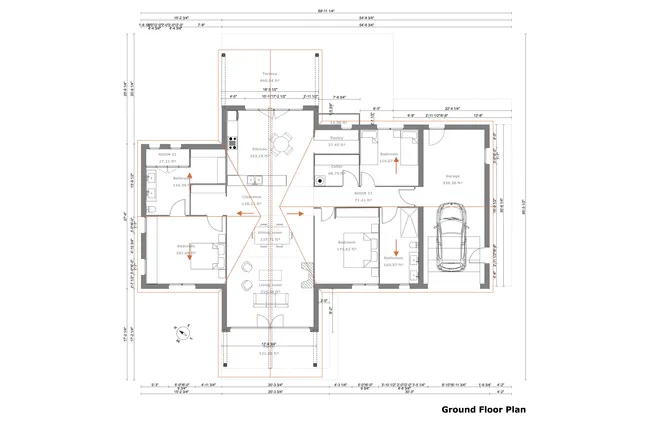
Design is where a house flip either maximizes profit or quietly bleeds money.
Most house flippers rush into demo without a full set of plans, and they end up making costly mid-project changes.
Smart flippers use a design-first approach (more details on this later in the article).
Instead of viewing design as an afterthought, treat design as its own phase in the house flipping process, with clear goals, timelines, and review steps.
- Start by deciding what type of buyer you’re designing for (first-time buyers, families, or local real estate investors looking for a rental property).
- Look at sold real estate listings in your area and note which layouts, kitchen sizes, and bathroom counts show up again and again.
- Your layout should support the property’s after-repair value instead of fighting it, so every wall move, doorway, and window earns its place in the plan.
Key Layout Choices that Drive ROI
Here are some layouts and floor plan updates that tend to help ROI:
- Bedroom and bathroom count that matches what local buyers expect in this price range.
- An open but not awkward main living area where kitchen, dining, and living relate well.
- A primary suite layout with privacy, storage, and a bath that feels updated, not overbuilt.
- Logical traffic flow that keeps people from walking through bedrooms to reach other rooms.
- Storage plans, including closets, pantry, and laundry, that help the flipped house live bigger.
Use Software Like Cedreo to Test Designs
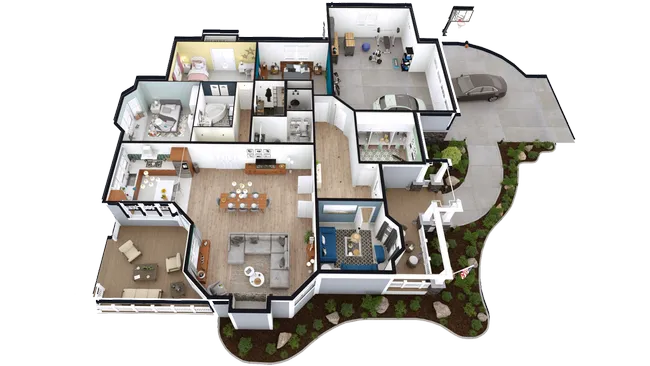
Instead of sketching rough ideas on paper, build your full floor plan in Cedreo so you can see how each change affects the whole house flip.
- Draw accurate 2D floor plans, then switch to 3D views to see the space like a buyer and spot tight hallways, dark corners, or wasted rooms.
- Create several layout options inside the same project to compare versions and pick the design that helps you sell high.
- Share Cedreo plans and 3D renderings with your contractors so they can flag concerns and give more accurate bids.
Step 5: Execute the Renovation
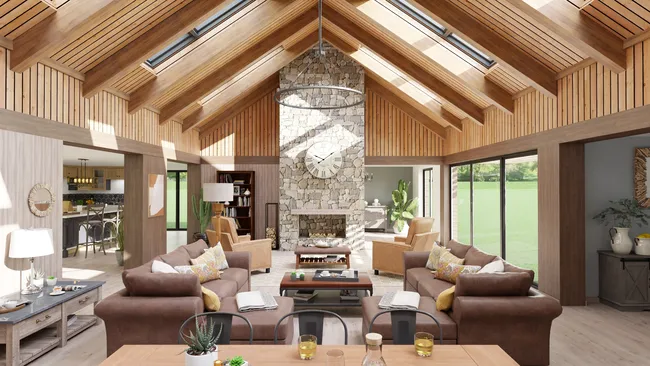
Once your design plans are locked in, executing the renovation becomes a clear checklist instead of a guessing game.
DIY vs. Contractors
Decide early which tasks you will handle yourself and which work you will hire contractors to perform.
A lot of house flippers limit DIY work to low-risk items and use contractors for items that affect safety and structure.
| Construction task | DIY difficulty | DIY recommendation | Hire out recommendation |
| Interior painting | Easy | Good DIY for most owners | Hire out for large or tight timelines |
| Basic landscaping | Easy | Good DIY weekend work | Hire out for full yard renovations |
| Interior non-structural demo | Medium | DIY with safety gear | Hire out if you’re unsure of what is structural and what’s not |
| Flooring install | Medium | DIY for simple plank floors | Hire out for tile or complex patterns |
| Roofing replacement | Hard | Not recommended DIY | Always use licensed roofing contractor |
| Electrical work | Hard | Only minor fixture swaps | Always use licensed electrician |
| Plumbing changes | Hard | Only simple fixture swaps | Use licensed plumber for new lines |
| HVAC install or change | Hard | Not recommended DIY | Always use licensed HVAC contractor |
| Structural framing changes | Hard | Not recommended DIY | Always use licensed structural pro |
Project Management for a House Flip
Treat your house flipping project like a small construction job with a simple schedule and scope of work.
Use these habits to streamline project management and protect profit on every house flip.
- Break the project into clear phases like demo, rough in, inspections, drywall, trim, and finishes so everyone knows what comes next.
- Lock your scope of work and build one master schedule before demo so trades are not waiting or stacked on top of each other.
- Hold a short weekly check in with key contractors to review progress, solve problems, and confirm next steps.
- Require daily jobsite photos or videos and simple written change orders so work stays aligned with your Cedreo plans and budget.
- Update your budget at least once a week so you spot overruns early and keep holding costs under control.
Step 6: Stage & Prepare for Sale
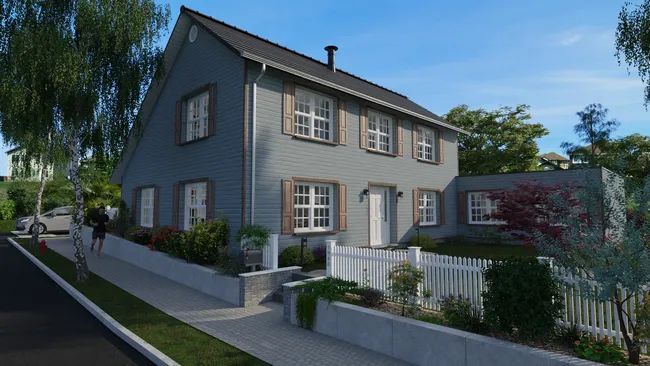
Staging and prep are where you turn a construction site into a flipped house that local buyers can picture themselves living in.
Start with curb appeal because many potential buyers decide how they feel about a flipped house before they even reach the front door.
Clean the yard, add fresh mulch, trim shrubs, pressure wash hard surfaces, and make sure the front entry is bright, simple, and inviting.
Inside, remove every bit of construction clutter so rooms feel calm and finished instead of like an active jobsite.
Use staging to highlight the strongest features of the property and distract from any limitations you cannot change.
These staging moves help maximize profit.
- Use smaller scale furniture so rooms feel larger and traffic paths stay open.
- Create one clear function for each space, like dining, office, or bonus room.
- Keep color palettes light and neutral so they appeal to the widest buyer pool.
- Add simple art, mirrors, and lamps to brighten dark corners and reflect light.
- Stage key rooms first, such as living room, kitchen, primary bedroom, and one secondary bedroom.
If you can’t fully stage the home, consider…
- Light staging with a few key pieces and high-quality photos.
- Virtual staging.
Professional real estate photography is non-negotiable because online real estate listings are your first open houses.
- Schedule photos for a time of day with good natural light and provide your photographer with Cedreo 3D views or floor plans to guide the best angles.
- Ask for a mix of wide room shots, detail images.
- Create a presentation that combines photos with a 3D floor plan graphic so buyers can understand the layout before they ever step inside.

Step 7: Market & Sell
Pricing, marketing, and a smooth closing are where you finally turn months of work into a real check.
Price to the property’s after repair value in today’s market, not just what you need to break even, and use a CMA from your real estate agent to stay anchored to real comps.
Gut check your list price with three quick questions.
- Do my comps truly match this flip in size, condition, and location?
- Will local buyers see clear value at this number?
- Does this price leave room for profit after closing, holding, and selling costs?
Once you set the price, treat marketing like a launch: feature professional photos, Cedreo floor plans, and 3D views so buyers are attracted to the finished design.
Schedule stacked showings and open houses, then weigh offers based on financing type, repair requests, and closing timeline as well as price.
Stay close to your real estate agent and closing team so inspections, appraisal, and paperwork stay on track.
Do all of this right and you can close smoothly and lock in profit.
Why Design is the Most Critical Phase of House Flipping

Good design is the moment when a rough investment property turns into a clear plan for a profitable house flip (instead of an expensive guess).
The Design-First Approach:
Most people think learning how to flip a house means buying low and then figuring out the remodel as they go.
That’s how budgets explode.
Traditional house flipping often looks like this:
- Buy
- Demolish rooms
- Make decisions in the dust
- Hope the final layout works for local buyers
A design first approach looks very different because you buy, create a detailed plan, then execute an organized renovation.
You decide on walls, doors, windows, finishes, and fixture locations in your design software first so crews are never waiting on you to make a choice.
This approach prevents costly mistakes that raise renovation costs, extend holding costs, and quietly eat into your ability to maximize profit.
How Smart Design Maximizes ROI:
Smart design for flipping houses is not about picking the fanciest materials, it is about choosing the improvements that move market value the most.
Use your plans to compare several layout options and ask which version will attract the biggest pool of potential buyers in your price range.
Create a simple list for each design so you can see where your money is working hardest.
- Structural or layout changes that add a true bedroom or bath.
- Updates that solve obvious problems, like tiny kitchens or awkward entries.
- Cosmetic upgrades that lift the look to match top real estate listings in the area.
The Role of Design Visualization:
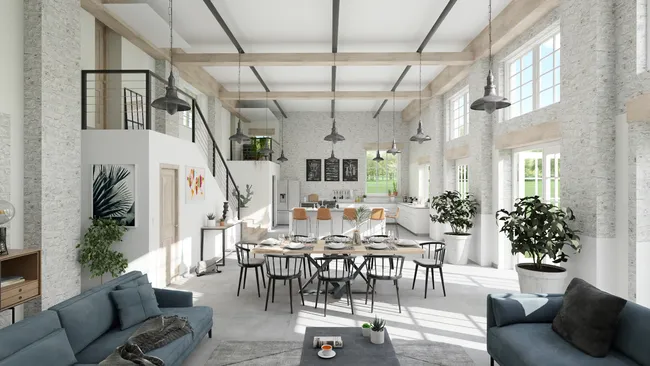
You can’t rely on imagination when tens of thousands of dollars ride on each design decision in a house flip.
A successful house flip gets everyone on the same page early on.
Use design visualization to get that shared vision in place.
- Align house flippers and contractors who might picture very different things when they hear “open floor plan” or “modern kitchen.”
- Visualize the finished space with professional house flipping design software before anyone swings a hammer.
- Use high quality 3D renderings and clear 2D and 3D floor plans to show how light, furniture, and traffic flow will actually work in the flipped house.
- Present a clear, consistent vision to contractors, real estate investors, lenders, and buyers so everyone agrees on the plan from day one.
Cedreo Features Flippers Love
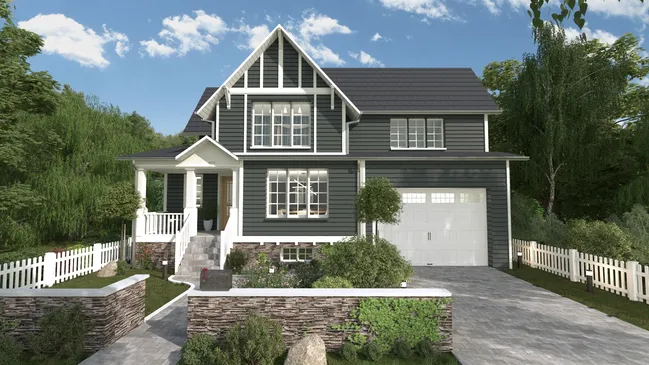
Cedreo gives house flippers everything they need to turn rough ideas into clear, buildable plans in one easy to use platform.
Ease of Use:
- Built for real estate investors and contractors without CAD training.
- Drag and drop walls, doors, windows, and furniture into your floor plan.
- Reuse templates and past projects across multiple house flips.
- Get help fast with live chat, tutorials, and dedicated email/phone support.
Speed:
- Move from rough idea to buildable plan in 2 hours.
- See instant 3D updates every time you move a wall or resize a room.
- Generate photorealistic renderings in minutes.
- Rework plans quickly when budgets or repair costs change.
Professional Results:
- Give your house flipping projects the look of a full design studio.
- Help appraisers, buyers, and lenders see the property’s after-repair value.
- Generate 2D and 3D floor plans, site plans, elevations, and cross sections.
- Add furniture, finishes, and exterior details that match real world selections.
- Use visuals in lender packets, listing presentations, and online real estate marketing to support a higher price and maximize profit.
Start Your Next House Flipping Project With Cedreo
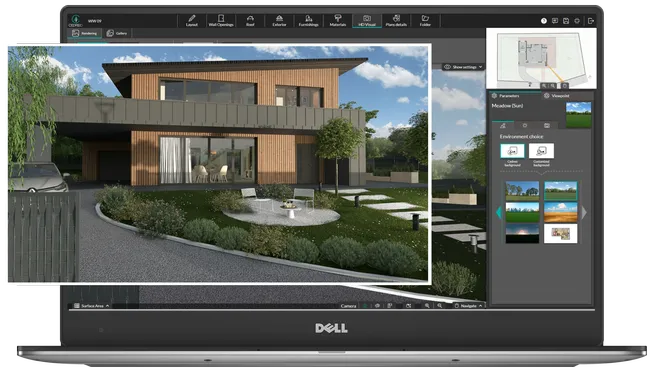
Learning how to flip a house can be a great way to make money in the real estate market, but it’s not without its risks. To reduce your risk of losing money on a flip, make sure you:
- Research the local market
- Create a realistic budget and schedule
- Choose the right upgrades
- Work with reliable contractors and a trusted real estate agent
And don’t forget, an easy-to-use 3D home design program like Cedreo is invaluable to house flippers!
- Import existing floor plans and create 3D home designs faster than ever
- Use 3D renderings to preview how a property will look
Try Cedreo for FREE today and see how it can help streamline your house flipping process.
House Flipping FAQs
Start with a clear plan for your target buyer, use design software like Cedreo to draw 2D and 3D floor plans, and make sure every change supports the property’s after repair value and your budget.
For most house flipping projects, buyers focus first on the kitchen and primary bathroom, so invest in layouts, cabinets, and fixtures there that match top local real estate listings.
An open floor plan often helps sell high, but use Cedreo or similar tools to test how much wall removal improves flow without hurting storage, furniture placement, or the layout of other areas.
Professional flippers often use 3D home design tools.
Cedreo is popular because it lets house flippers quickly create 2D and 3D plans, renderings, and layouts they can share with contractors and buyers.
The best layout for resale usually has three bedrooms, two baths, a functional open living area, good storage, and traffic flow that fits what local buyers in your price range expect.



